英语常见的介词及用法
- 格式:doc
- 大小:18.50 KB
- 文档页数:2
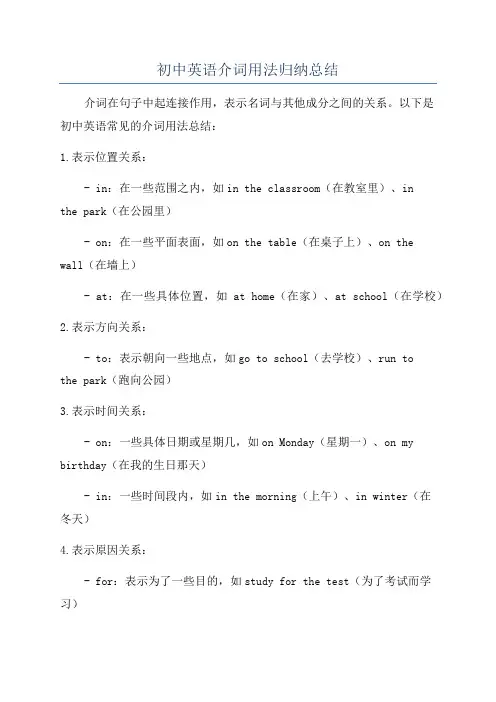
初中英语介词用法归纳总结介词在句子中起连接作用,表示名词与其他成分之间的关系。
以下是初中英语常见的介词用法总结:1.表示位置关系:- in:在一些范围之内,如in the classroom(在教室里)、inthe park(在公园里)- on:在一些平面表面,如on the table(在桌子上)、on thewall(在墙上)- at:在一些具体位置,如at home(在家)、at school(在学校)2.表示方向关系:- to:表示朝向一些地点,如go to school(去学校)、run tothe park(跑向公园)3.表示时间关系:- on:一些具体日期或星期几,如on Monday(星期一)、on my birthday(在我的生日那天)- in:一些时间段内,如in the morning(上午)、in winter(在冬天)4.表示原因关系:- for:表示为了一些目的,如study for the test(为了考试而学习)- because of:表示因为一些原因,如because of the rain(因为下雨)5.表示方式或手段:- by:通过其中一种方式或手段,如by bus(乘公交车)、by email(通过邮件)6.表示比较、对照关系:- than:与人或物进行比较,如I am taller than my brother(我比我兄弟高)7.表示从属关系:- of:表示所属关系,如the book of the teacher(老师的书)- to:表示归属关系,如a friend to me(对我来说的一个朋友)这些是初中英语中常见的介词用法,但还有其他一些特殊用法,需要根据具体语境来确定使用。
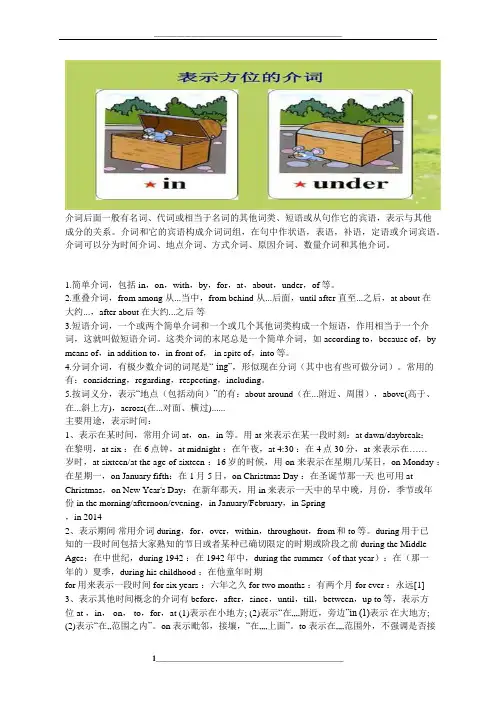
介词后面一般有名词、代词或相当于名词的其他词类、短语或从句作它的宾语,表示与其他成分的关系。
介词和它的宾语构成介词词组,在句中作状语,表语,补语,定语或介词宾语。
介词可以分为时间介词、地点介词、方式介词、原因介词、数量介词和其他介词。
1.简单介词,包括in,on,with,by,for,at,about,under,of等。
2.重叠介词,from among 从...当中,from behind 从...后面,until after 直至...之后,at about 在大约...,after about 在大约...之后等3.短语介词,一个或两个简单介词和一个或几个其他词类构成一个短语,作用相当于一个介词,这就叫做短语介词。
这类介词的末尾总是一个简单介词,如 according to,because of,by means of,in addition to,in front of, in spite of,into等。
4.分词介词,有极少数介词的词尾是“-ing”,形似现在分词(其中也有些可做分词)。
常用的有:considering,regarding,respecting,including。
5.按词义分,表示“地点(包括动向)”的有:about around(在...附近、周围),above(高于、在...斜上方),across(在...对面、横过)......主要用途,表示时间:1、表示在某时间,常用介词at,on,in等。
用 at 来表示在某一段时刻:at dawn/daybreak:在黎明,at six :在6点钟,at midnight :在午夜,at 4:30 :在4点30分,at 来表示在……岁时,at sixteen/at the age of sixteen :16岁的时候,用 on 来表示在星期几/某日,on Monday :在星期一,on January fifth:在1月5日,on Christmas Day :在圣诞节那一天也可用at Christmas,on New Year's Day:在新年那天,用in来表示一天中的早中晚,月份,季节或年份in the morning/afternoon/evening,in January/February,in Spring,in 20142、表示期间常用介词during,for,over,within,throughout,from和to等。
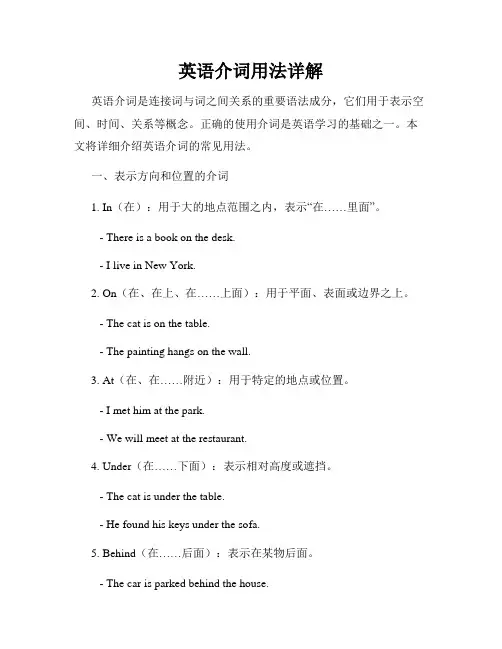
英语介词用法详解英语介词是连接词与词之间关系的重要语法成分,它们用于表示空间、时间、关系等概念。
正确的使用介词是英语学习的基础之一。
本文将详细介绍英语介词的常见用法。
一、表示方向和位置的介词1. In(在):用于大的地点范围之内,表示“在……里面”。
- There is a book on the desk.- I live in New York.2. On(在、在上、在……上面):用于平面、表面或边界之上。
- The cat is on the table.- The painting hangs on the wall.3. At(在、在……附近):用于特定的地点或位置。
- I met him at the park.- We will meet at the restaurant.4. Under(在……下面):表示相对高度或遮挡。
- The cat is under the table.- He found his keys under the sofa.5. Behind(在……后面):表示在某物后面。
- The car is parked behind the house.- She is hiding behind the tree.6. Beside(在……旁边):表示在某物的旁边。
- My house is beside the park.- She sat beside her friends.7. Inside(在……里面):表示在某物的内部。
- The wallet is inside the bag.- There is a surprise inside the box.8. Outside(在……外面):表示在某物的外部。
- The children are playing outside the house.- Don't forget to lock the door when you go outside.二、表示时间的介词1. On(在某天):用于特定的日期。
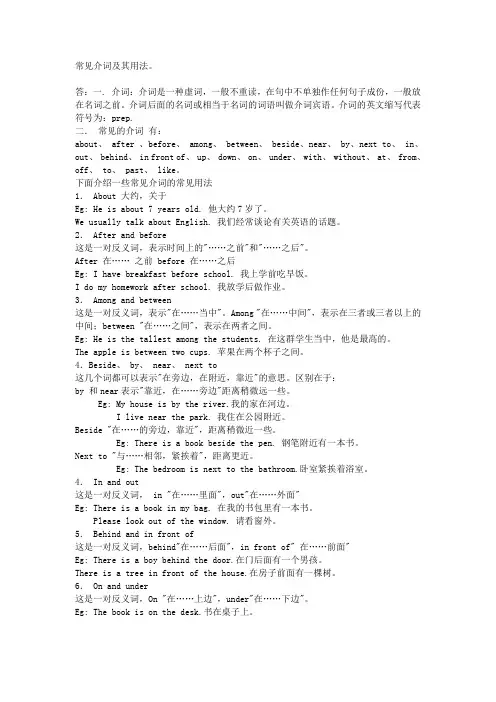
常见介词及其用法。
答:一. 介词:介词是一种虚词,一般不重读,在句中不单独作任何句子成份,一般放在名词之前。
介词后面的名词或相当于名词的词语叫做介词宾语。
介词的英文缩写代表符号为:prep.二.常见的介词有:about、 after 、before、 among、 between、 beside、near、 by、next to、 in、out、 behind、 in front of、 up、 down、 on、 under、 with、 without、 at、 from、off、 to、 past、 like。
下面介绍一些常见介词的常见用法1. About 大约,关于Eg: He is about 7 years old. 他大约7岁了。
We usually talk about English. 我们经常谈论有关英语的话题。
2. After and before这是一对反义词,表示时间上的"……之前"和"……之后"。
After 在…… 之前 before 在……之后Eg: I have breakfast before school. 我上学前吃早饭。
I do my homework after school. 我放学后做作业。
3. Among and between这是一对反义词,表示"在……当中"。
Among "在……中间",表示在三者或三者以上的中间;between "在……之间",表示在两者之间。
Eg: He is the tallest among the students. 在这群学生当中,他是最高的。
The apple is between two cups. 苹果在两个杯子之间。
4.Beside、 by、 near、 next to这几个词都可以表示"在旁边,在附近,靠近"的意思。
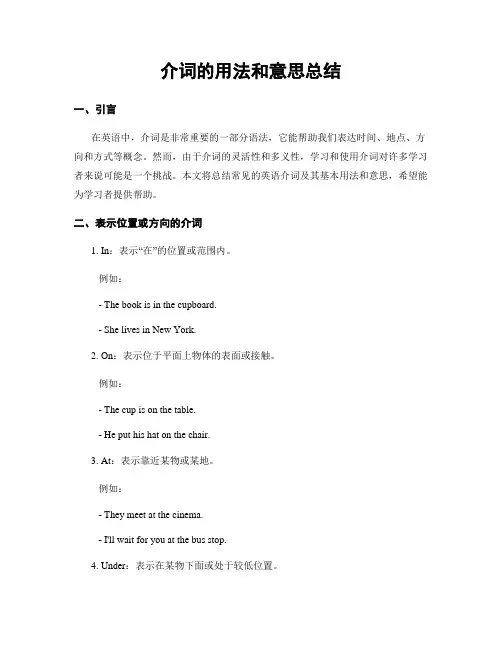
介词的用法和意思总结一、引言在英语中,介词是非常重要的一部分语法,它能帮助我们表达时间、地点、方向和方式等概念。
然而,由于介词的灵活性和多义性,学习和使用介词对许多学习者来说可能是一个挑战。
本文将总结常见的英语介词及其基本用法和意思,希望能为学习者提供帮助。
二、表示位置或方向的介词1. In:表示“在”的位置或范围内。
例如:- The book is in the cupboard.- She lives in New York.2. On:表示位于平面上物体的表面或接触。
例如:- The cup is on the table.- He put his hat on the chair.3. At:表示靠近某物或某地。
例如:- They meet at the cinema.- I'll wait for you at the bus stop.4. Under:表示在某物下面或处于较低位置。
例如:- The cat is under the table.- The box is under the bed.5. Above:表示在某物之上或较高位置。
例如:- The bird is flying above the tree.- Hang the picture above the sofa.三、表示时间的介词1. On:表示特定日期或星期几。
例如:- My birthday is on May 5th.- We have a meeting on Monday.2. At:表示具体的时刻。
例如:- The train will arrive at 9 o'clock.- I go to bed at midnight.3. In:表示时间段或月份。
例如:- I will visit my parents in summer.- She was born in January.四、表示原因和目的的介词1. For:表示动作发生的原因或目的。
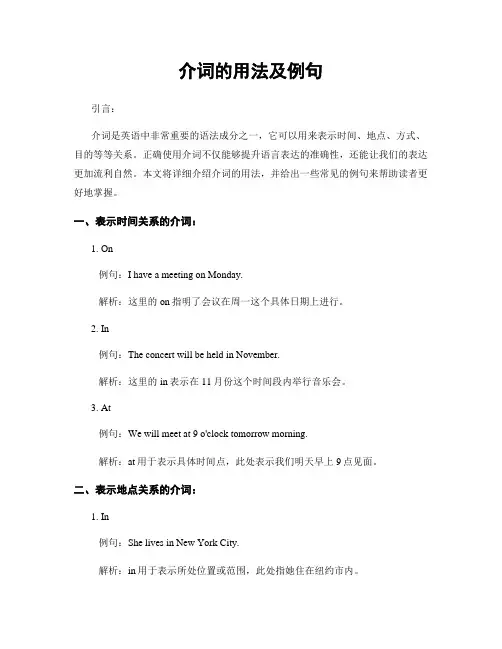
介词的用法及例句引言:介词是英语中非常重要的语法成分之一,它可以用来表示时间、地点、方式、目的等等关系。
正确使用介词不仅能够提升语言表达的准确性,还能让我们的表达更加流利自然。
本文将详细介绍介词的用法,并给出一些常见的例句来帮助读者更好地掌握。
一、表示时间关系的介词:1. On例句:I have a meeting on Monday.解析:这里的on指明了会议在周一这个具体日期上进行。
2. In例句:The concert will be held in November.解析:这里的in表示在11月份这个时间段内举行音乐会。
3. At例句:We will meet at 9 o'clock tomorrow morning.解析:at用于表示具体时间点,此处表示我们明天早上9点见面。
二、表示地点关系的介词:1. In例句:She lives in New York City.解析:in用于表示所处位置或范围,此处指她住在纽约市内。
例句:I will meet you at the coffee shop.解析:at表示在某个特定地方遇见某人,这里指我将在咖啡店见你。
3. On例句:The book is on the table.解析:on表示在某物的表面,这里指书本放在桌子上。
三、表示方式关系的介词:1. By例句:She goes to work by bus.解析:by表示通过某种交通工具或方式进行,这里指她乘公交车上班。
2. With例句:He cuts the meat with a knife.解析:with表示使用某物进行操作,这里指他用刀切肉。
3. Like例句:He speaks English like a native speaker.解析:like表示像某人或某事物一样,这里指他说英语像个母语者一样流利。
四、表示目的关系的介词:1. For例句:I bought some flowers for my mother.解析:for表示为了某人或某事物而做,这里我买花是为了给妈妈。
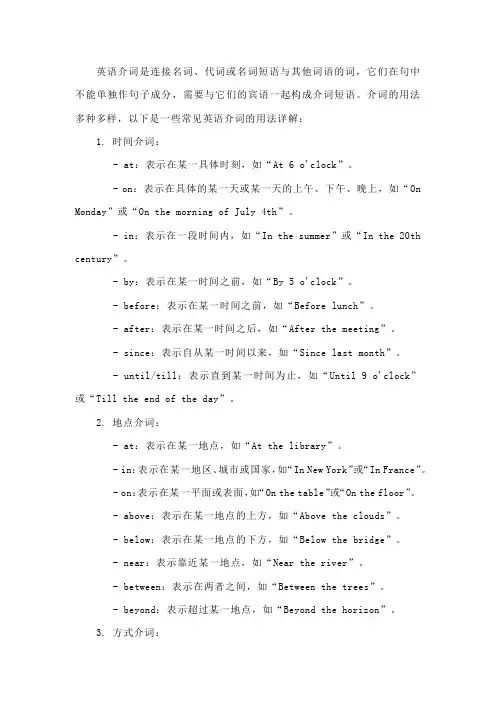
英语介词是连接名词、代词或名词短语与其他词语的词,它们在句中不能单独作句子成分,需要与它们的宾语一起构成介词短语。
介词的用法多种多样,以下是一些常见英语介词的用法详解:1. 时间介词:- at:表示在某一具体时刻,如“At 6 o'clock”。
- on:表示在具体的某一天或某一天的上午、下午、晚上,如“On Monday”或“On the morning of July 4th”。
- in:表示在一段时间内,如“In the summer”或“In the 20th century”。
- by:表示在某一时间之前,如“By 5 o'clock”。
- before:表示在某一时间之前,如“Before lunch”。
- after:表示在某一时间之后,如“After the meeting”。
- since:表示自从某一时间以来,如“Since last month”。
- until/till:表示直到某一时间为止,如“Until 9 o'clock”或“Till the end of the day”。
2. 地点介词:- at:表示在某一地点,如“At the library”。
- in:表示在某一地区、城市或国家,如“In New York”或“In France”。
- on:表示在某一平面或表面,如“On the table”或“On the floor”。
- above:表示在某一地点的上方,如“Above the clouds”。
- below:表示在某一地点的下方,如“Below the bridge”。
- near:表示靠近某一地点,如“Near the river”。
- between:表示在两者之间,如“Between the trees”。
- beyond:表示超过某一地点,如“Beyond the horizon”。
3. 方式介词:- by:表示通过某种方式或手段,如“By car”或“By phone”。
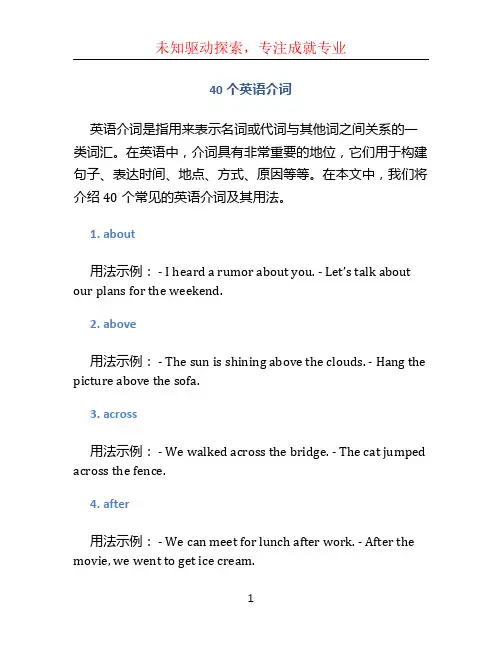
40个英语介词英语介词是指用来表示名词或代词与其他词之间关系的一类词汇。
在英语中,介词具有非常重要的地位,它们用于构建句子、表达时间、地点、方式、原因等等。
在本文中,我们将介绍40个常见的英语介词及其用法。
1. about用法示例: - I heard a rumor about you. - Let’s talk about our plans for the weekend.2. above用法示例: - The sun is shining above the clouds. - Hang the picture above the sofa.3. across用法示例: - We walked across the bridge. - The cat jumped across the fence.4. after用法示例: - We can meet for lunch after work. - After the movie, we went to get ice cream.5. against用法示例: - He leaned against the wall. - The cat rubbed against my leg.6. along用法示例: - We walked along the beach. - Drive along the highway until you see the sign.7. among用法示例: - There is a sense of camaraderie among the team members. - The book is hidden among the other books on the shelf.8. around用法示例: - The children ran around the playground. - We walked around the park.9. as用法示例: - She worked as a teacher for many years. - You can use this hammer as a tool.10. at用法示例: - I met him at the café. - The meeting is scheduled at noon.11. before用法示例: - Let’s finish this task before the deadline. - He left the house before sunrise.12. behind用法示例: - The car is parked behind the building. - He hid behind the tree.13. below用法示例: - The temperature is below freezing. - The answer is written below the question.14. beneath用法示例: - The treasure is buried beneath the sand. - He found a note hidden beneath the pillow.15. beside用法示例: - She sat beside her friend. - Put the book beside the vase.16. between用法示例: - I couldn’t decide between the re d or blue dress. - The lake is located between the mountains.17. beyond用法示例: - His achievements go beyond his qualifications. - The house is just beyond the hills.18. by用法示例: - The package was delivered by the mailman. - I traveled to London by plane.19. despite用法示例: - He continued working despite the fatigue. - Despite the rain, we went for a walk.20. down用法示例: - We walked down the stairs. - The book fell down from the shelf.21. during用法示例: - We went on vacation during the summer. - I read a book during the flight.22. except用法示例: - Everyone was present except for John. - We ate all the cake except for one slice.23. for用法示例: - This gift is for you. - He studied for hours.24. from用法示例: - He received a letter from his friend. - She ran away from the crowd.25. in用法示例: - The book is in the bag. - She lives in Paris.26. inside用法示例: - He is waiting inside the building. - The keys are inside my pocket.27. into用法示例: - He jumped into the pool. - Pour the milk into a glass.28. like用法示例: - I feel like going for a walk. - He looks like his father.29. near用法示例: - There is a coffee shop near the office. - The playground is near the school.30. of用法示例: - She is the mother of two children. - The top of the mountain was covered in snow.31. off用法示例: - He took the hat off his head. - The plane took off from the runway.32. on用法示例: - The book is on the table. - I put on my coat.33. out用法示例: - He stepped out of the house. - She blew out the candles.用法示例: - The cat is sitting outside the window. - He is waiting outside the door.35. over用法示例: - We talked over dinner. - The ball jumped over the fence.36. past用法示例: - She walked past the store. - We drove past the old church.37. round用法示例: - We sat around the table. - The bus goes round the city.38. through用法示例: - He read through the book. - They walked through the forest.39. to用法示例: - He gave the present to his sister. - We went to the park.用法示例: - The cat is sleeping under the table. - The book is under the bed.以上是40个常用的英语介词及其用法。
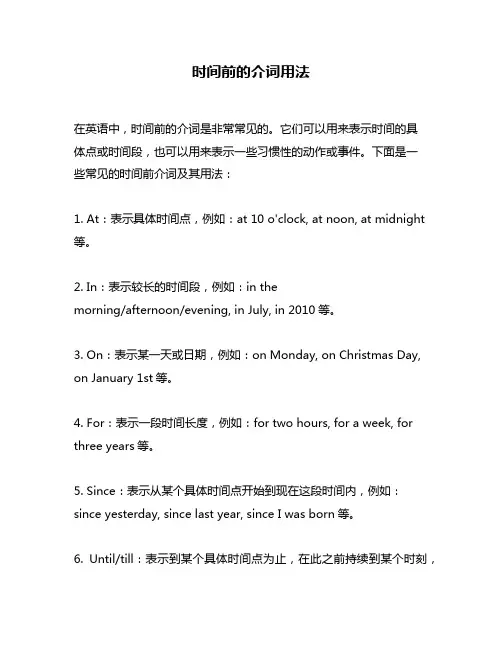
时间前的介词用法
在英语中,时间前的介词是非常常见的。
它们可以用来表示时间的具
体点或时间段,也可以用来表示一些习惯性的动作或事件。
下面是一
些常见的时间前介词及其用法:
1. At:表示具体时间点,例如:at 10 o'clock, at noon, at midnight 等。
2. In:表示较长的时间段,例如:in the
morning/afternoon/evening, in July, in 2010等。
3. On:表示某一天或日期,例如:on Monday, on Christmas Day, on January 1st等。
4. For:表示一段时间长度,例如:for two hours, for a week, for three years等。
5. Since:表示从某个具体时间点开始到现在这段时间内,例如:since yesterday, since last year, since I was born等。
6. Until/till:表示到某个具体时间点为止,在此之前持续到某个时刻,
例如:until/till tomorrow, until/till the end of the month等。
7. By:表示最晚完成某事情的限制时间,例如:by 5 o'clock, by the end of the week等。
8. From/to: 表示一个区间范围内的起始和终止点,例如: from Monday to Friday.
需要注意的是,在使用这些介词时需要注意与其他单词搭配使用时可能产生的语法错误。
同时,在口语交流中也要注意发音和语调以避免产生歧义。
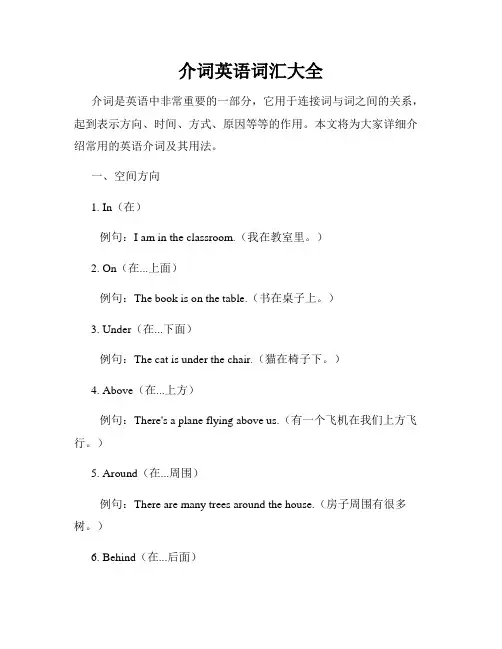
介词英语词汇大全介词是英语中非常重要的一部分,它用于连接词与词之间的关系,起到表示方向、时间、方式、原因等等的作用。
本文将为大家详细介绍常用的英语介词及其用法。
一、空间方向1. In(在)例句:I am in the classroom.(我在教室里。
)2. On(在...上面)例句:The book is on the table.(书在桌子上。
)3. Under(在...下面)例句:The cat is under the chair.(猫在椅子下。
)4. Above(在...上方)例句:There's a plane flying above us.(有一个飞机在我们上方飞行。
)5. Around(在...周围)例句:There are many trees around the house.(房子周围有很多树。
)6. Behind(在...后面)例句:The car is behind the building.(车在建筑物后面。
)7. Beside(在...旁边)例句:She sat beside her friend.(她坐在她朋友旁边。
)二、时间关系1. At(在某个具体时间)例句:He will arrive at 8 o'clock.(他将在8点到达。
)2. On(在某一天)例句:We have a meeting on Monday.(我们星期一有个会议。
)3. In(在某个时间段)例句:I will meet her in an hour.(我将在一个小时后见她。
)4. Before(在...之前)例句:Please finish your homework before dinner.(请在晚饭前完成作业。
)5. After(在...之后)例句:We will have a party after the concert.(音乐会之后我们将举办派对。
)三、方式和方式1. With(用;以...方式)例句:She wrote the letter with a pen.(她用钢笔写信。
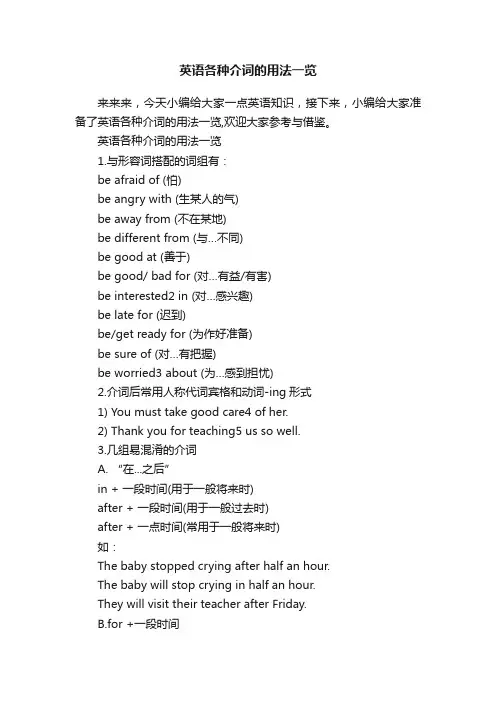
英语各种介词的用法一览来来来,今天小编给大家一点英语知识,接下来,小编给大家准备了英语各种介词的用法一览,欢迎大家参考与借鉴。
英语各种介词的用法一览1.与形容词搭配的词组有:be afraid of (怕)be angry with (生某人的气)be away from (不在某地)be different from (与…不同)be good at (善于)be good/ bad for (对…有益/有害)be interested2 in (对…感兴趣)be late for (迟到)be/get ready for (为作好准备)be sure of (对…有把握)be worried3 about (为…感到担忧)2.介词后常用人称代词宾格和动词-ing形式1) You must take good care4 of her.2) Thank you for teaching5 us so well.3.几组易混淆的介词A. “在...之后”in + 一段时间(用于一般将来时)after + 一段时间(用于一般过去时)after + 一点时间(常用于一般将来时)如:The baby stopped crying after half an hour.The baby will stop crying in half an hour.They will visit their teacher after Friday.B.for +一段时间since6 +过去的一点时间这两者均用于现在完成时,具体在时态部分,我会继续向同学们讲解。
C.be made7 of "用……制成"be made in “由某地制造”be made by somebody8 “由某人制成”D.in,on,at 表时间in 表示“在某月(季节、年等)”如:in 1996, in January, in summer固定词组:in the morning, in a week,in a minute,in time, in the endon 用于指具体的某一天或专指某一天上午、下午或晚上等。
英语介词的用法简介介词是英语中常见的一类词性,用来表示名词或代词与其他词语之间的关系。
在英语中,介词的使用非常广泛,几乎无处不在。
了解和掌握英语介词的用法是提高语言运用能力的重要一步。
本文将对英语介词的常见用法进行详细介绍。
常见的英语介词在英语中,有许多常用的介词,如下所示:•in(在)•on(在…上)•at(在…处)•of(关于)•by(通过)•to(到)•for(为了)•with(与…一起)•from(从…来)•about(关于)•among(在…之中)•between(在…之间)这些介词在日常生活和学习中经常被用到,我们需要了解其用法和搭配。
介词的基本用法介词通常与名词或代词一起构成介词短语,表示位置、方向、时间、原因、方式等关系。
下面是一些常见的用法示例:1.表示位置关系–The book is on the table.(这本书在桌子上。
)–My house is in the city.(我的房子在城市里。
)–He is standing behind the door.(他站在门后。
)2.表示方向关系–I’m going to the supermarket.(我去超市。
)–She walked towards the park.(她朝着公园走去。
)–The train is coming from the north.(火车是从北方来的。
)3.表示时间关系–We have a meeting at10 o’clock.(我们在10点开会。
)–He usually sleeps during the day.(他通常在白天睡觉。
)–The party will be held on Saturday.(派对将于星期六举行。
)4.表示原因和目的–She went to the library for studying.(她去图书馆是为了学习。
)–He apologized for his mistake.(他为自己的错误道歉。
初一英语常见介词用法归纳介词在英语中起到连接词的作用,连接名词、代词、动词、形容词或副词等成分。
在初中英语学习过程中,介词是一个非常重要的语法项目。
我们需要对初中英语中常见的介词用法进行归纳整理,以便更好地掌握这一部分知识。
一、介词的基本用法1. 表示位置:in, on, at- in: 在…里面(较大的范围)e.g. in the box- on:在…上面e.g. on the table- at:在…处e.g. at the bus stop4. 表示原因:because of, due to- because of: 由于e.g. He was late because of the heavy traffic.- due to: 由于e.g. The cancellation of the event was due to bad weather.5. 表示方式:by, with- by: 通过…手段e.g. by bus- with: 用…方式e.g. with a smile9. 表示所属:of- of: …的e.g. the hat of the boy2. look forward to: 期待e.g. I am looking forward to the summer vacation.5. be interested in: 对…感兴趣e.g. Amy is interested in learning Chinese.三、常见介词错误用法及纠正1. 错误用法:depend of正确用法:depend one.g. We depend on each other.通过以上的介词错误用法及纠正,我们可以更清晰地了解该如何正确使用这些介词。
四、综合练习通过上述的综合练习,可以帮助大家更好地掌握介词用法。
英语中常⽤介词的基本⽤法⼀些常⽤介词的基本⽤法⼀、表⽰“时间”的介词1.at1)表⽰时间的⼀点Eg. at six在六点at noon 在中午at midnight2)表“短时间”At breakfast 在早餐时at night 在晚上at Christmas 在圣诞节时2.On1)⽤于“⽇期、周⽇”on Sunday 在星期⽇,on Saturday 在星期六on may 1st在五⽉⼀⽇2)表具体时间,具体⽇期On July 17 在7⽉17⽇on a hot afternoon 在⼀个炎热的下午3.In1)⽤于“周,⽉,年,世纪”之前In the week 在这周,in December 在12⽉in Spring 在春天(spring 还有弹簧的意思)。
In the 18th century 在⼗⼋世纪2)⽤于泛指的上午、下午、晚上In the morning(afternoon、evening)在上午(中午、晚上)4.Before在……之前Eg. We will come to the city before September 1st九⽉⼀⽇前我们将来到这个城市。
She was a teacher before she came to this city。
在来这座城市之前,她是⼀名教师。
We’ ll see that film (before long). 我们不久(或会⼉)将要看那部电影了。
5.After 在……之后Eg. After dinner I usually have a walk.我经常饭后散步。
We play football after school。
课后后我们踢⾜球。
They will return the day after tomorrow。
他们后天回来。
6.During在……期间During the summer holidays.在暑假期间During the week 本周期间During the last few years在最近⼏年。
介词英语用法介词是一种连接词,在句子中用来连接名词、代词、动词或形容词等成分。
介词的功能是指示名词或代词与其他词在句中的关系,它往往构成介词短语,用来修饰或补充名词或代词的意义。
常用的介词包括:in、on、at、to、with、for、from、of、by、about、like 等。
下面是一些常见的介词用法:1. in表示“在……之中”,常用于表示时间、地点、状态等。
例如:- I will meet you in the park.- She was born in 1990.- He is in good health.2. on表示“在……上面”,常用于表示日期、时间、节日、表面等。
例如:- The book is on the table.- We will have a party on Christmas Day.- I usually go to bed on time.3. at表示“在……的地点、时间或情况”,常用于表示时间、地点、活动等。
例如:- We will meet at the station at 7 o'clock.- He is good at playing basketball.- I am at home now.4. to表示“到达”,常用于表示动作的方向。
例如:- I am going to the store.- He went to the park to play basketball.- She is walking to the school.5. with表示“带有……”,常用于表示伴随、附带等。
例如:- I went to the movies with my friends.- She is wearing a dress with flowers on it.- He plays the guitar with great skill.6. for表示“为了……”,常用于表示目的、原因、价值等。
英语介词用法
英语介词是一种虚词,用于连接名词、代词或其他词类与句子中的其他成分。
它们在句子中起到了连接和修饰的作用,使句子更加准确、清晰。
以下是一些常见的英语介词用法:
1. 表示时间:at(在某一时刻)、in(在某一段时间内)、on (在某一天或特定日期)、by(在某一特定时间之前)、for(持续一段时间)等。
2. 表示地点:at(在某一具体地点)、in(在某一范围内)、on(在某一表面上)、under(在某一物体下面)、behind(在某一物体后面)等。
3. 表示方向:to(朝着某一方向)、from(来自某一地方)、through(穿过某一空间)、along(沿着某一路径)等。
4. 表示原因:for(由于)、because of(因为)、due to(由于)等。
5. 表示目的:for(为了)、to(为了)等。
6. 表示方式:by(通过某种方式)、with(用某种工具或手段)等。
7. 表示比较:like(像)、as(像……一样)、than(比)等。
需要注意的是,英语介词的用法比较复杂,需要根据具体语境和
句子结构来判断使用哪一个介词。
在学习和使用介词时,需要多读多练,逐渐掌握其用法。
初一英语常见介词用法归纳初一学生学习英语时,介词是一个重要的语法知识点。
介词在句子中起着连接词语,修饰名词或代词的作用。
正确使用介词可以让句子更通顺、地道。
在这里,我们将归纳总结一下初一英语常见的介词用法,希望对初学者的英语学习有所帮助。
二、表示时间的介词1. At:表示具体的时间点。
- We have a meeting at 9 o'clock.- He gets up at 7:30 every morning.2. In:表示在……年、月、季节、年龄等时间段。
- We have a holiday in summer.- Her birthday is in May.3. On:表示某一天或日期。
- We have a party on Sunday.- My friend's birthday is on December 3rd.4. During:表示在……期间。
- I watch TV during the weekend.- She reads books during the summer vacation.5. For:表示持续的时间。
- I have been learning English for 3 years.- They will stay in Beijing for 2 weeks.四、表示目的的介词1. For:表示为了……。
- I bought a present for my mother.- He is studying hard for the final exam.2. To:表示去某个地方的方向,也表示给某人或某物。
- I go to school by bike.- She gives a gift to her friend.。
常见介词及其用法。
答:一、介词:介词就是一种虚词,一般不重读,在句中不单独作任何句子成份,一般放在名词之前。
介词后面的名词或相当于名词的词语叫做介词宾语。
介词的英文缩写代表符号为:prep、
二. 常见的介词有:
about、after 、before、among、between、beside、near、by、next to、in、out、behind、in front of、up、down、on、under、with、without、at、from、off、to、past、like。
下面介绍一些常见介词的常见用法
1. About 大约,关于
Eg: He is about 7 years old、她大约7岁了。
We usually talk about English、我们经常谈论有关英语的话题。
2. After and before
这就是一对反义词,表示时间上的"……之前"与"……之后"。
After 在…… 之前before 在……之后
Eg: I have breakfast before school、我上学前吃早饭。
I do my homework after school、我放学后做作业。
3. Among and between
这就是一对反义词,表示"在……当中"。
Among "在……中间",表示在三者或三者以上的中间;between "在……之间",表示在两者之间。
Eg: He is the tallest among the students、在这群学生当中,她就是最高的。
The apple is between two cups、苹果在两个杯子之间。
4.Beside、by、near、next to
这几个词都可以表示"在旁边,在附近,靠近"的意思。
区别在于:
by 与near表示"靠近,在……旁边"距离稍微远一些。
Eg: My house is by the river、我的家在河边。
I live near the park、我住在公园附近。
Beside "在……的旁边,靠近",距离稍微近一些。
Eg: There is a book beside the pen、钢笔附近有一本书。
Next to "与……相邻,紧挨着",距离更近。
Eg: The bedroom is next to the bathroom、卧室紧挨着浴室。
4. In and out
这就是一对反义词, in "在……里面",out"在……外面"
Eg: There is a book in my bag、在我的书包里有一本书。
Please look out of the window、请瞧窗外。
5. Behind and in front of
这就是一对反义词,behind"在……后面",in front of" 在……前面"
Eg: There is a boy behind the door、在门后面有一个男孩。
There is a tree in front of the house、在房子前面有一棵树。
6. On and under
这就是一对反义词,On "在……上边",under"在……下边"。
Eg: The book is on the desk、书在桌子上。
The ball is under the chair、球在椅子下边。
7. Up and down
这就是一对反义词,up"向上", down"向下"。
Eg: Stand up, please、起立!
Sit down, please、请坐!
8. With and without
With "与……在一起"。
表示伴随。
Without "没有"
Eg: I often go shopping with my mother、我经常与妈妈一起去购物。
Fish can't live without water、鱼离开水就不能活。
9. In、on、at
这三个词既可以表示地点,又可以表示时间。
1) 表示地点
in 在……里面。
There is a book in my bag、在我的书包里有一本书。
on在……上面。
The book is on the desk、书在桌子上。
at 在(指某一具体地点)。
My mother is at the bus stop、我妈妈正在车站。
2) 表示时间
in 表示笼统的时间。
Eg: I was born in January、我出生在一月份。
On 表示具体的时间,在出现日期时使用。
Eg: I was born on June 5th、我出生在六月五日。
At 表示时间的某一点。
Eg: I go to school at seven in the morning、我早晨7点钟去上学。
10. Off 离开,脱离
Eg: The plane is taking off、飞机正在起飞。
11. From 从…来
E、g: Where are you from? I'm from China、
您从哪里来?我来自中国。
12. To 到…
Eg: go to bed上床睡觉
Please come to my home tomorrow、请明天来我家。
13. Past 过(时间表达词,一般在半个小时之内表示过了几分钟,这种表达法要先说分钟,后说小时,中间加介词past)。
Eg: I get up at ten past six、我在六点十分起床
To 差(时间表达词,一般在半个小时以后表示还差几分钟就到下一个小时了。
这种表达法也就是先说分钟,后说小时,中间加to、但就是所用的小时要用下一个小时
Eg: It is ten to one、现在就是12:50。
(差10分钟1点。
)
14. Like
这个词可以做动词, 就是"喜欢"的意思。
还可以做介词,就是"象……一样"的意思。
Eg: You look like your mother、您瞧上去很像您的妈妈。